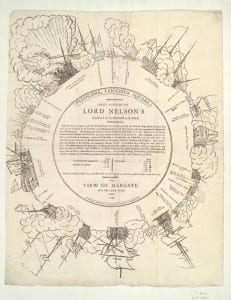The final C19 session of this academic year will take place on Thursday 14th April in MB1012. Sibylle Erle (Bishop Grosseteste University) will talk to us on ‘War, Napoleon and the Panorama’.
Refreshments will be served from 5pm and the paper will begin at 5.15pm.
Sibylle’s abstract and biography are below.
Abstract
Robert Barker, the originator of the panorama, patented his invention which successfully represented a view of 360° in 1787 and opened a purpose-built rotunda in Leicester Square in 1793. The first panorama shown at Leicester Square was the Grand Fleet at Spithead, being the Russian Armament in 1791. Like the annual exhibition at the Royal Academy it was opened by George III. According to Henry Aston Barker’s Memoirs (1857), Joshua Reynolds, the president of the Royal Academy, though initially skeptical of the invention, came to support and admire it – as did his successor Benjamin West. When Barker’s patent expired in 1801, a rival venue opened in the Strand; several other venues operated across the country. They were never in competition as they shared resources and coordinated showings. The panorama has been discussed as inferior art, mass entertainment, a precursor of the cinema and virtual reality. This talk will discuss the interaction between war and society within the space of the panorama as well as explore the development of panorama’s visual technology, its representation of war and commentary on the French Napoleonic wars. Sketches have survived but none of the original paintings. What we have to go by are reviews, eye-witness accounts and the schematic reproductions at the back of the narrative programmes. This talk seeks to establish the Panorama as a space in which visitors were inadvertently encouraged to critically engage with the topic represented: it will historically situate the panorama and determine how the ambitions of the panorama painters helped shape and promote very specific ideas about the French Napoleonic Wars and Napoleon.
The battle of Waterloo not only marked the end of the French Napoleonic wars, its significance lies in the high number of causalities. In Waterloo and the Romantic Imagination (2002) Phil Shaw points to the perceived failure of language to express what had happened, which is why, he explains, many took recourse to the aesthetic of the sublime, while gauging the battle’s meaning for the nation. Responses to Waterloo generally were ambivalent, wavering between elation about the victory and dejection about the suffering. Simon Bainbridge in Napoleon and English Romanticism (1995) compares the different poetic responses to Napoleon, i.e. how interpretations of Napoleon’s destiny and character sit with governmental or official narratives and radical counter-narratives. This talk is part of a project on Lord Byron’s, Walter Scott’s and Charlotte Eaton’s first responses to the field of Waterloo as well as the visual strategies of the panoramas to make sense of ‘Waterloo’. Most of the primary research on the Waterloo panoramas dates back to Panoramas, 1787-1900: Texts and Contexts (2012) with Laurie Garrison as general editor.
Biography
Sibylle Erle, FRSA, is Senior Lecturer in English at Bishop Grosseteste University Lincoln, author of Blake, Lavater and Physiognomy (Legenda, 2010), co-editor of Science, Technology and the Senses (Special Issue for RaVoN, 2008), volume editor of Panoramas, 1787-1900: Texts and Contexts (5 vols., Pickering & Chatto, 2012) and co-editor of The Reception of William Blake in Europe (Bloomsbury, 2017). She co-curated the display “Blake and Physiognomy” (2010-11) at Tate Britain and devised an online exhibition of Tennyson’s copy of Blake’s Job for the Tennyson Research Centre (2013). Apart from Blake’s reception, she is working on ‘character’ in the Romantic period, writing on Tennyson, Mary Shelley and the Panorama and collaborating with Jim Cheshire, Ewan Jones and Phyllis Weliver on a project which will digitally archive objects of the Tennyson Archive.


Recent Comments